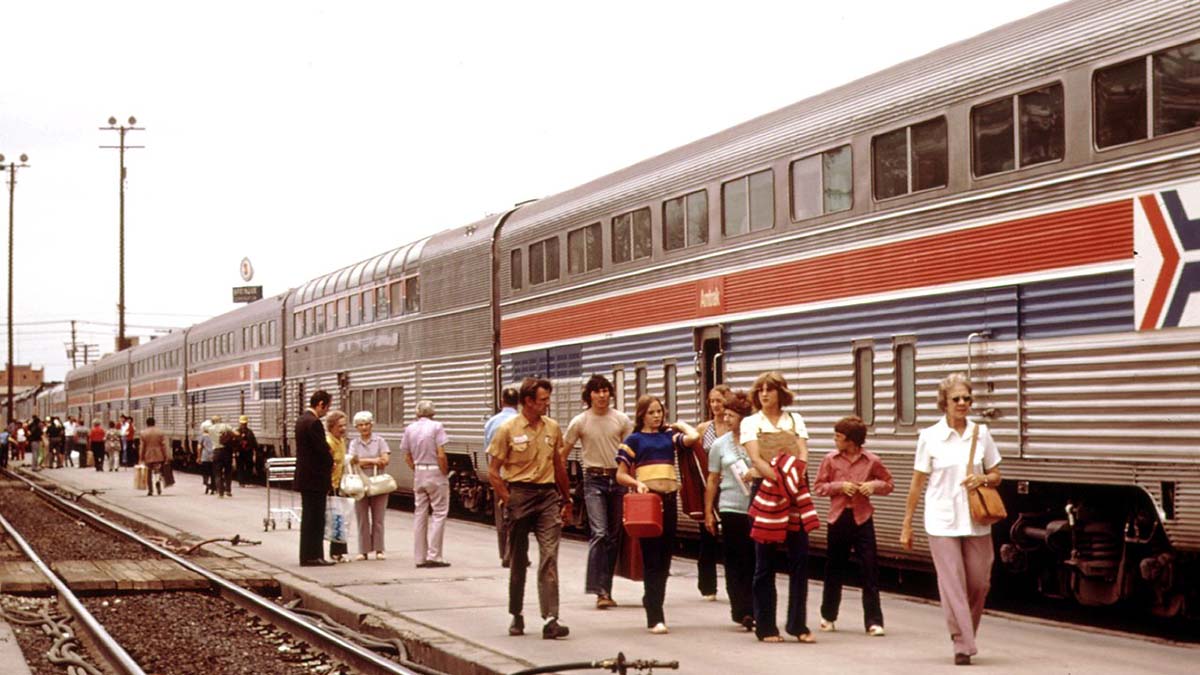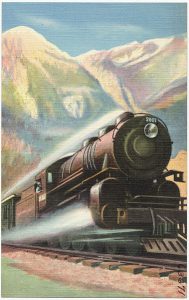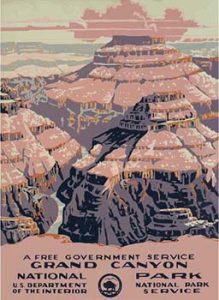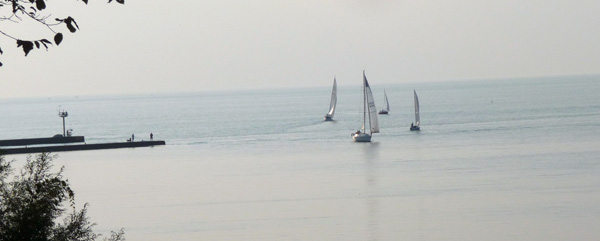
by Karen S. Roberts
While looking for a quiet lakeside rental cottage for a short vacation, I stumbled upon Olcott Beach in the tiny hamlet of Olcott, NY. Not only did I find a cottage, but I discovered a quaint town with some interesting history.
 Back in the early 1900’s, Olcott Beach was a resort area. When a trolley line was put in place between the towns of Lockport and Olcott in 1900, summer visitors flocked to the beach to enjoy the cool breezes of Lake Ontario and entertainment. Also vacationers arrived by steamship. During the early years of the 1900’s, over 100,000 tourists arrived yearly.
Back in the early 1900’s, Olcott Beach was a resort area. When a trolley line was put in place between the towns of Lockport and Olcott in 1900, summer visitors flocked to the beach to enjoy the cool breezes of Lake Ontario and entertainment. Also vacationers arrived by steamship. During the early years of the 1900’s, over 100,000 tourists arrived yearly.
Visiting Olcott now, it’s hard to believe that it once teemed with tourists. The streets near the beach are lined with numerous summer cottages. At the Beachfront Vacation Cottages where we stayed, my husband and I enjoyed sitting on the deck each day, looking out over the beautiful lake with its sailboats, speedboats, kayakers, ducks, and sea gulls. On a nearby marina pier, several fishermen enjoyed the summer weather and each other’s company into the evening. But there were no big crowds.
Olcott Beach especially became popular when The Luna Amusement Park opened in 1898, featuring live entertainment at the Dreamland Dance Hall. As the crowds increased due to the trolley, eight hotels opened in the area to accommodate folks who came to enjoy the beach and entertainment.
The most popular hotel was the Olcott Grand Hotel, with one hundred rooms and a huge veranda overlooking the beach. Swimmers had direct access to the water from the hotel. But the real draw for tourists was the Grand Ballroom of 14,000 square feet. It was the beginning of the Big Band era, and popular musicians performed there. These included Guy Lombardo and Louis Armstrong.
Unfortunately, due to the Great Depression when people had little money to spend, in addition to the increase in automobile ownership, the hotel business at Olcott Beach and many other Lake Ontario tourist communities floundered. People could drive to the beach for a day and return home without spending money on a hotel. In 1927 a huge fire wiped out many buildings and the amusement park along the main part of the tourist area. The Grand Hotel was repaired, but only survived a few more years. Due to deterioration, the building was demolished in 1937.
Then in 1942 there was an upswing of summer visitors, although not the hotel business. The new Olcott Amusement Park became a tourist attraction. But it closed in 1986. Another small amusement park called New Rialto was open at Olcott Beach during some of those years as well. These small parks couldn’t compete with Darien Lake Amusement Park, which is now a Six Flags park. That park is only 43 miles from Olcott and opened in the early 1980’s.
Today Olcott is still an attraction for swimming, boating, and fishing. The town now sponsors major fishing derbies which draw in folks who love to compete for trophy fish. In 2012, Olcott Beach won the title of “Ultimate Fishing Town” in an annual contest sponsored by The World Fishing Network. The deep harbor is well known as a great place to catch salmon and trout.
The area north of Main Street in Olcott is the part of town called Olcott Beach. One of the unique characteristics is what might be the tiniest boardwalk anywhere with just a few seasonal shops.
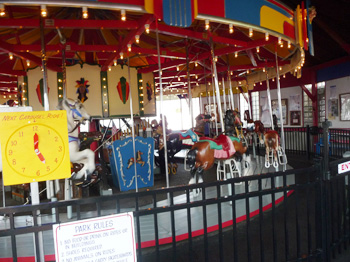 When we parked near the shops, we immediately heard the “oom-pa-pa” of a carousel’s Wurlizer Band organ. The Olcott Beach Carousel Park was developed in 2003-2004 by local volunteers who raised funds for building a vintage amusement park.. It features an old time Herschell-Spillman two-row carousel and a few other kiddie rides for only 25 cents a ride! They can do this because the park is staffed by volunteers and is incorporated as a nonprofit organization. When you enter this quaint park you feel like you are going back in time to around 1945.
When we parked near the shops, we immediately heard the “oom-pa-pa” of a carousel’s Wurlizer Band organ. The Olcott Beach Carousel Park was developed in 2003-2004 by local volunteers who raised funds for building a vintage amusement park.. It features an old time Herschell-Spillman two-row carousel and a few other kiddie rides for only 25 cents a ride! They can do this because the park is staffed by volunteers and is incorporated as a nonprofit organization. When you enter this quaint park you feel like you are going back in time to around 1945.
The local volunteers who restored the round carousel building made sure that it resembled the original one that was built in the 1940’s. The volunteers take pride in letting children experience the fun of simple amusements like the ones enjoyed when their grandparents were children. This cute little park is open from Memorial Day Weekend through Labor Day each year.
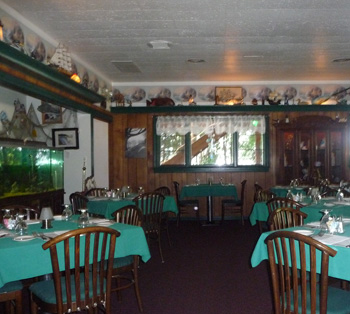 After a stroll through the mini-boardwalk and the park, we went around the corner to eat at the Mariner’s Landing restaurant. We chose to eat inside due to the heat that evening. But we could have eaten on an outdoor upper deck which offers a stunning view of Lake Ontario and nearby Krull Park. The inside was filled with nautical decor, especially on an upper ledge that ran all the way around the dining room. It was filled with models of ships, lighthouses, sea captains, and other knick-knacks. They were fascinating to look at.
After a stroll through the mini-boardwalk and the park, we went around the corner to eat at the Mariner’s Landing restaurant. We chose to eat inside due to the heat that evening. But we could have eaten on an outdoor upper deck which offers a stunning view of Lake Ontario and nearby Krull Park. The inside was filled with nautical decor, especially on an upper ledge that ran all the way around the dining room. It was filled with models of ships, lighthouses, sea captains, and other knick-knacks. They were fascinating to look at.
Both of us ordered fish dinners. The waiter seemed a bit impatient as we asked questions about substitutions for potatoes and coleslaw, but he also was quite busy covering several tables in the dining room as well as out front on the sidewalk. Later he stopped by and in a more friendly way chatted about how to cook cabbage. We enjoyed our dinners and viewing the decor. We had to wait awhile to get our check, but overall eating there was fun.
 After our meal we needed to walk off some calories and wandered across the narrow street into the beautiful 325-acre Krull Park. The park overlooks the lake in the area where the old Grand Hotel once stood. We didn’t go down the steep stone step pathway to the beach below where the swimming area is, but enjoyed the view from above. The park is pleasantly arranged with benches, picnic areas, and pavilions. We heard that over the summer several festivals take place at the park. Across Main St. is another section of the park. In a drive-by, we could see busy recreation fields and courts that were full of kids playing sports, along with spectators. A cheerleading squad was practicing within sight of the street also.
After our meal we needed to walk off some calories and wandered across the narrow street into the beautiful 325-acre Krull Park. The park overlooks the lake in the area where the old Grand Hotel once stood. We didn’t go down the steep stone step pathway to the beach below where the swimming area is, but enjoyed the view from above. The park is pleasantly arranged with benches, picnic areas, and pavilions. We heard that over the summer several festivals take place at the park. Across Main St. is another section of the park. In a drive-by, we could see busy recreation fields and courts that were full of kids playing sports, along with spectators. A cheerleading squad was practicing within sight of the street also.
Within the park is a playground with a water spray area, as well as two ice skating rinks. This small community obviously takes pride in their park. It was very clean and nicely landscaped.
That evening we finished our day back on the deck at the cottage, hoping for a spectacular sunset over Lake Ontario. Although the sky was somewhat colorful each evening as the sun went down, we didn’t see the stunning sunsets that are often enjoyed at the lake.
I felt like we should have planned to stay a day or two longer to see other sights in the area. Olcott isn’t far from Niagara Falls and the Erie Canal that runs through Lockport. I’d like to return again next year during one of the festivals. If so, I hope to see one of those amazing sunsets!
If You Go:
♦ Olcott Beach Carousel Park
♦ Newfane and Olcott Beach Tourism Facebook Page
♦ More Info About Olcott
♦ The Buffalo News review of Mariner’s Landing
♦ History of Herschell-Spillman Carousel Making
About the author:
Karen S. Roberts, a free-lance writer and blogger, lives in Rochester, NY. You can visit her author page at amazon.com/author/karenrobertsbooks. Some of her blogs are become-a-secret-shopper.com, daily-devotionals.com, and bestgymnasticsvideos.com.
Photo credits:
It’s unusual to see four sailboats so close together on the lake – by Karen S. Roberts
It’s fun to visit these little shops that are only open during the tourist season – by Karen S. Roberts
The community takes pride in maintaining the vintage carousel – by Karen S. Roberts
Mariner’s Landing is a relaxing place to get a fish dinner in a unique nautical-themed atmosphere – by David Roberts
Krull Park, overlooking Lake Ontario – by David Roberts



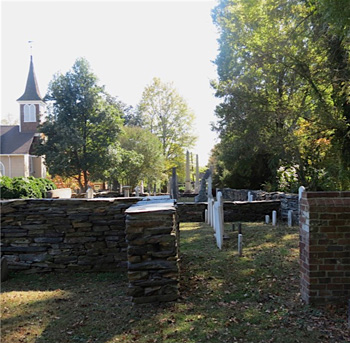 by Connie Pearson
by Connie Pearson 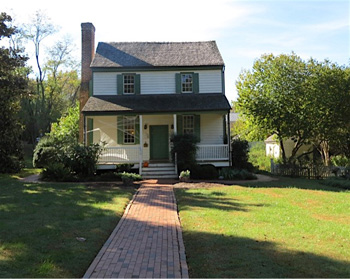 Driving into town, the first logical stop is the Dickson House at 150 E. King Street, which has Civil War significance and now serves as the Orange County Visitor Center. Park your car and see a 7-minute video giving an overview of Hillsborough’s history. Arrange for a guided tour, ask for information about restaurants, shopping, and town events, or purchase a walking tour booklet for $4.00. Make note of the public restrooms available on the grounds. The walking tour will take you past 46 well-documented structures, and 5 more are within a short drive. Most of the homes and offices are privately owned, but guided tours are available for Ayr Mount, Burwell School, and the gardens of Montrose.
Driving into town, the first logical stop is the Dickson House at 150 E. King Street, which has Civil War significance and now serves as the Orange County Visitor Center. Park your car and see a 7-minute video giving an overview of Hillsborough’s history. Arrange for a guided tour, ask for information about restaurants, shopping, and town events, or purchase a walking tour booklet for $4.00. Make note of the public restrooms available on the grounds. The walking tour will take you past 46 well-documented structures, and 5 more are within a short drive. Most of the homes and offices are privately owned, but guided tours are available for Ayr Mount, Burwell School, and the gardens of Montrose.
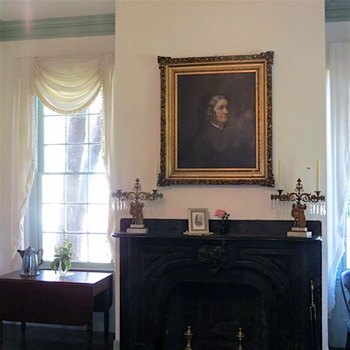 During a tour of The Burwell School Historic Site, you will hear many stories about the Burwell family, particularly wife and mother Anna Burwell. She was the very accomplished and well-educated wife of Robert, minister of Hillsborough Presbyterian Church. She did such an impressive job of educating her own 12 children, she drew the attention of a local doctor who asked her to teach his daughter as well. Anna Burwell saw that as an opportunity to supplement her husband’s meager salary. From that small beginning, she went on to oversee the educations of more than 200 young women from 1837-1857.
During a tour of The Burwell School Historic Site, you will hear many stories about the Burwell family, particularly wife and mother Anna Burwell. She was the very accomplished and well-educated wife of Robert, minister of Hillsborough Presbyterian Church. She did such an impressive job of educating her own 12 children, she drew the attention of a local doctor who asked her to teach his daughter as well. Anna Burwell saw that as an opportunity to supplement her husband’s meager salary. From that small beginning, she went on to oversee the educations of more than 200 young women from 1837-1857. A fascinating side story from those school years has ultimately drawn greater attention. A household slave girl named Elizabeth Hobbs Keckly worked strenuously for Mrs. Burwell. Although “Lizzie” had a harsh life, she eventually bought her freedom and became an accomplished dressmaker with such famous clients as Mrs. Robert E. Lee and Mrs. Abraham Lincoln. Mrs. Lincoln invited Lizzie to live in the White House and be her personal dresser. In that role she also became Mrs. Lincoln’s confidante, much of which is chronicled in Keckly’s book
A fascinating side story from those school years has ultimately drawn greater attention. A household slave girl named Elizabeth Hobbs Keckly worked strenuously for Mrs. Burwell. Although “Lizzie” had a harsh life, she eventually bought her freedom and became an accomplished dressmaker with such famous clients as Mrs. Robert E. Lee and Mrs. Abraham Lincoln. Mrs. Lincoln invited Lizzie to live in the White House and be her personal dresser. In that role she also became Mrs. Lincoln’s confidante, much of which is chronicled in Keckly’s book 
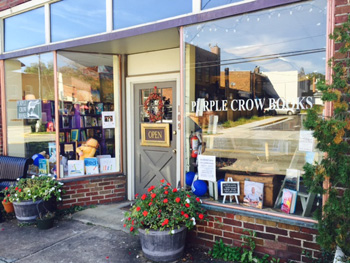 You will probably work up an appetite with all of that walking. If so, Saratoga Grill at 108 S. Churton Street, is a delicious choice. New England clam chowder, Honey Almond Salmon, and scones are specialties. Blackened scallops, salads with house-made dressings, peppered swordfish, or the broiled seafood platter are other savory options. Every dish bursts with flavor. Doors open at 11:30 a.m. Arrive about that time. It will be completely full by 12:30.
You will probably work up an appetite with all of that walking. If so, Saratoga Grill at 108 S. Churton Street, is a delicious choice. New England clam chowder, Honey Almond Salmon, and scones are specialties. Blackened scallops, salads with house-made dressings, peppered swordfish, or the broiled seafood platter are other savory options. Every dish bursts with flavor. Doors open at 11:30 a.m. Arrive about that time. It will be completely full by 12:30. Frances Mayes, author of Under the Tuscan Sun, recently described Hillsborough this way: “After only two years, Hillsborough seems like the home I never left. When my family and I decided to move to North Carolina after decades in San Francisco, we kept hearing from friends in this area, ‘You must move to Hillsborough — that’s where all the writers and artists live.’ Being writers ourselves, we were magnetized by the idea of a town where creativity thrives, and, having grown up in a small town in Georgia, I wanted to return to a place with an intense sense of community. By great good luck, I found both, and more.”
Frances Mayes, author of Under the Tuscan Sun, recently described Hillsborough this way: “After only two years, Hillsborough seems like the home I never left. When my family and I decided to move to North Carolina after decades in San Francisco, we kept hearing from friends in this area, ‘You must move to Hillsborough — that’s where all the writers and artists live.’ Being writers ourselves, we were magnetized by the idea of a town where creativity thrives, and, having grown up in a small town in Georgia, I wanted to return to a place with an intense sense of community. By great good luck, I found both, and more.”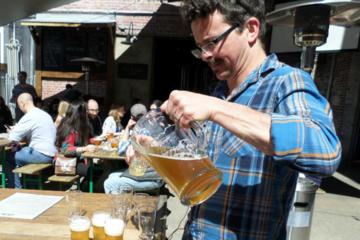

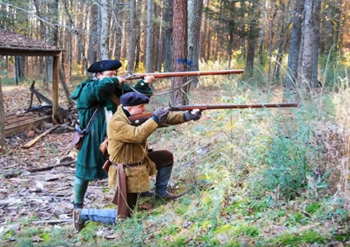
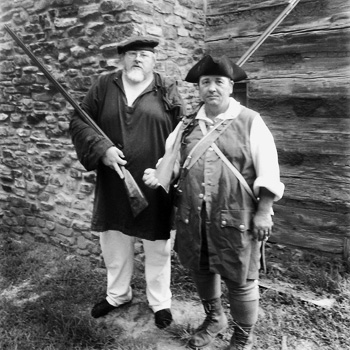 When I arrived, I saw two large mud holes filled with children. And this was not some delicate, mash-the-mud-barefooted activity. This was full-contact mayhem, requiring everyone’s Outside Voice. Children were rolling in the red clay muck, happy as a butcher’s dog. Possibly, some of the more enthusiastic participants needed to be hosed off before their parents could even recognize them.
When I arrived, I saw two large mud holes filled with children. And this was not some delicate, mash-the-mud-barefooted activity. This was full-contact mayhem, requiring everyone’s Outside Voice. Children were rolling in the red clay muck, happy as a butcher’s dog. Possibly, some of the more enthusiastic participants needed to be hosed off before their parents could even recognize them.
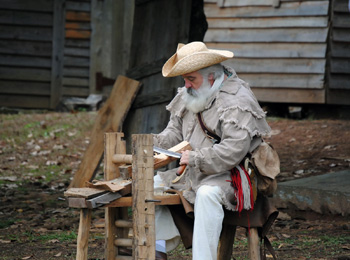 This was not a place where a rope or a “stay back” sign separated you from the action. The Society volunteers let visitors pitch in as fully as safety allowed. A young girl shelled dry corn into a wooden bowl while another waited her turn to grind it with a large pestle. And three tomahawk targets, unmolested today, hinted at more fun that could be had some other time.
This was not a place where a rope or a “stay back” sign separated you from the action. The Society volunteers let visitors pitch in as fully as safety allowed. A young girl shelled dry corn into a wooden bowl while another waited her turn to grind it with a large pestle. And three tomahawk targets, unmolested today, hinted at more fun that could be had some other time.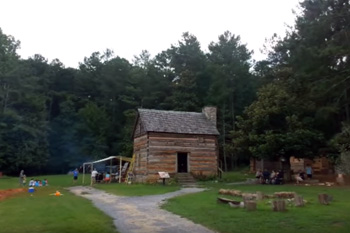 For example, we were discussing the small sheds near the fort. When I asked if you could take a regular shed and add fake woodwork to make it look authentic, Darrell, the volunteer Sergeant of Arms who diplomatically refrained from thumping me on the forehead, was very definite in his response.
For example, we were discussing the small sheds near the fort. When I asked if you could take a regular shed and add fake woodwork to make it look authentic, Darrell, the volunteer Sergeant of Arms who diplomatically refrained from thumping me on the forehead, was very definite in his response.

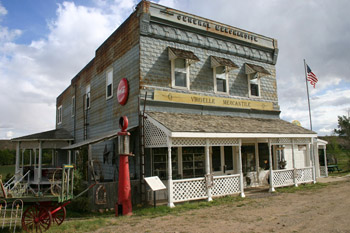
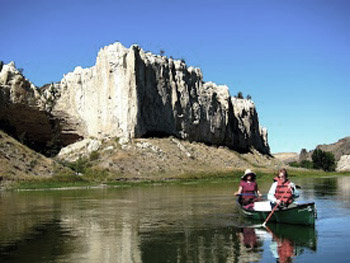 Rather than the tame goings-on of the last couple of centuries, it’s the little-known facts about Lewis and Clark and their expedition through un-mapped Missouri River wilderness which guide Mike Nottingham loves to discuss. This mountain man, trapper, fisherman, and river guide for the Missouri River Canoe Company even teaches you how to pronounce Sacagawea’s name correctly.
Rather than the tame goings-on of the last couple of centuries, it’s the little-known facts about Lewis and Clark and their expedition through un-mapped Missouri River wilderness which guide Mike Nottingham loves to discuss. This mountain man, trapper, fisherman, and river guide for the Missouri River Canoe Company even teaches you how to pronounce Sacagawea’s name correctly.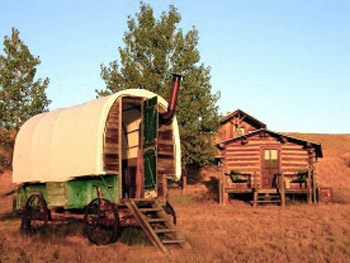 I went one step further. I chose the sheep wagon. How could I resist? It looked like one of the coolest places I would ever sleep. And it was. All night I heard coyotes howling in the distance as the light of the half moon glimmered through my canvas-topped covered wagon. I felt like Laura Ingalls.
I went one step further. I chose the sheep wagon. How could I resist? It looked like one of the coolest places I would ever sleep. And it was. All night I heard coyotes howling in the distance as the light of the half moon glimmered through my canvas-topped covered wagon. I felt like Laura Ingalls.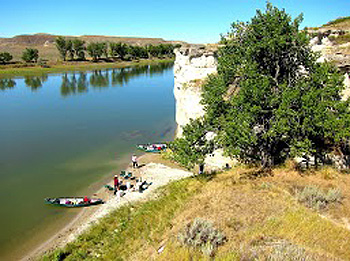 From our canoes, we didn’t see another soul on the river or bank, not a house, not even a broken-down homesteader’s shack. In fact, the Missouri Breaks landscape today, thanks to stewardship and land management, looks pretty much the way it would have looked to Lewis and Clark, even more so now than in the brief late-19th century steamboat days when trees were felled to fuel the boats. “The only difference now,” said Nottingham, “are the occasional Russian olive trees along the banks, which are invasive.” There’s also the odd cow which comes down from one of the ranches for a drink. Back then, of course, it would have been buffalo.
From our canoes, we didn’t see another soul on the river or bank, not a house, not even a broken-down homesteader’s shack. In fact, the Missouri Breaks landscape today, thanks to stewardship and land management, looks pretty much the way it would have looked to Lewis and Clark, even more so now than in the brief late-19th century steamboat days when trees were felled to fuel the boats. “The only difference now,” said Nottingham, “are the occasional Russian olive trees along the banks, which are invasive.” There’s also the odd cow which comes down from one of the ranches for a drink. Back then, of course, it would have been buffalo.
